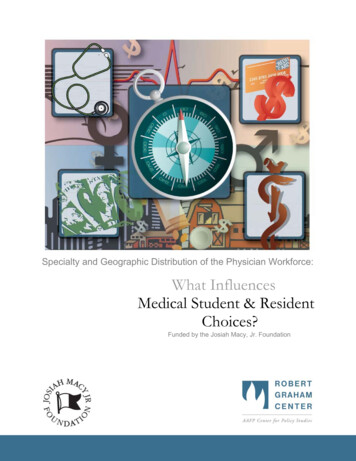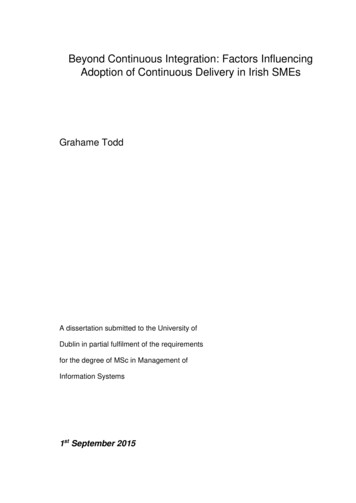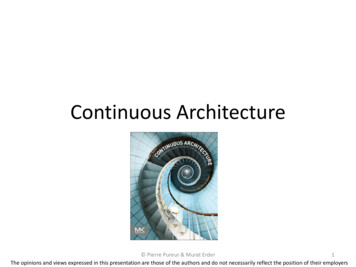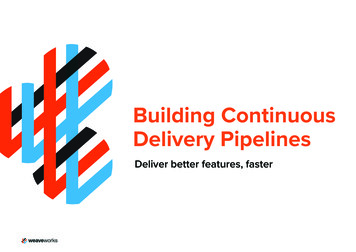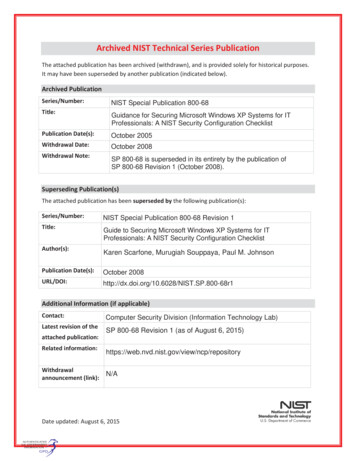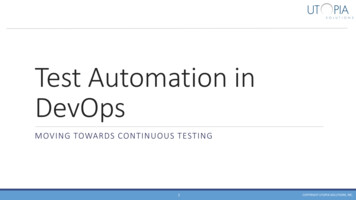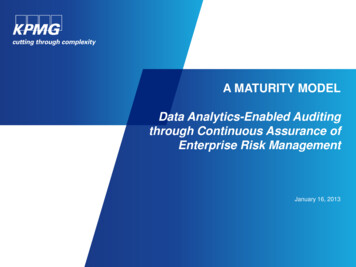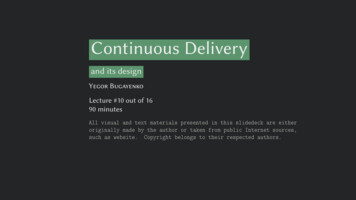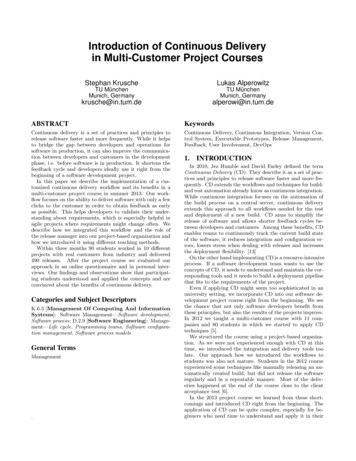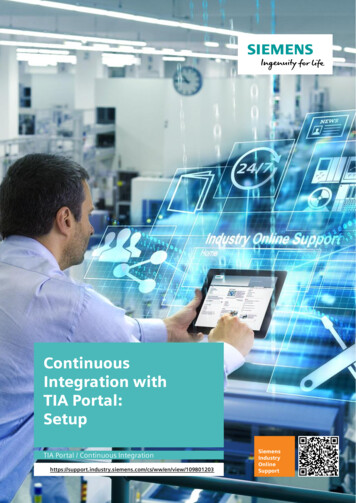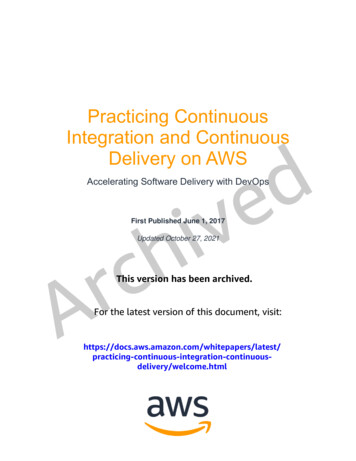
Transcription
Practicing ContinuousIntegration and ContinuousDelivery on AWSAccelerating Software Delivery with DevOpsFirst Published June 1, 2017Updated October 27, 2021This version has been archived.For the latest version of this document, ivery/welcome.html
NoticesCustomers are responsible for making their own independent assessment of theinformation in this document. This document: (a) is for informational purposes only, (b)represents current AWS product offerings and practices, which are subject to changewithout notice, and (c) does not create any commitments or assurances from AWS andits affiliates, suppliers or licensors. AWS products or services are provided “as is”without warranties, representations, or conditions of any kind, whether express orimplied. The responsibilities and liabilities of AWS to its customers are controlled byAWS agreements, and this document is not part of, nor does it modify, any agreementbetween AWS and its customers. 2021 Amazon Web Services, Inc. or its affiliates. All rights reserved.This version has been archived.For the latest version of this document, ivery/welcome.html
ContentsThe challenge of software delivery .1What is continuous integration and continuous delivery/deployment? .2Continuous integration .2Continuous delivery and deployment .2Continuous delivery is not continuous deployment .3Benefits of continuous delivery .3Implementing continuous integration and continuous delivery .4A pathway to continuous integration/continuous delivery .5Teams .9Testing stages in continuous integration and continuous delivery .10Building the pipeline .13Pipeline integration with AWS CodeBuild.22Pipeline integration with Jenkins.23Deployment methods .24All at once (in-place deployment) .26Rolling deployment.26Thisdeploymentsversion hasbeen archived.Immutable and blue/green.26Database schema changes.27Summary of bestForpractices28the .latest version of this document, visit:Conclusion .29Further reading Contributors ivery/welcome.htmlDocument revisions .30
AbstractThis paper explains the features and benefits of using continuous integration andcontinuous delivery (CI/CD) along with Amazon Web Services (AWS) tooling in yoursoftware development environment. Continuous integration and continuous delivery arebest practices and a vital part of a DevOps initiative.This version has been archived.For the latest version of this document, ivery/welcome.html
Amazon Web ServicesPracticing Continuous Integration and Continuous Delivery on AWSThe challenge of software deliveryEnterprises today face the challenges of rapidly changing competitive landscapes,evolving security requirements, and performance scalability. Enterprises must bridgethe gap between operations stability and rapid feature development. Continuousintegration and continuous delivery (CI/CD) are practices that enable rapid softwarechanges while maintaining system stability and security.Amazon realized early on that the business needs of delivering features forAmazon.com retail customers, Amazon subsidiaries and Amazon Web Services (AWS)would require new and innovative ways of delivering software. At the scale of acompany like Amazon, thousands of independent software teams must be able to workin parallel to deliver software quickly, securely, reliably, and with zero tolerance foroutages.By learning how to deliver software at high velocity, Amazon and other forward-thinkingorganizations pioneered DevOps. DevOps is a combination of cultural philosophies,practices, and tools that increase an organization’s ability to deliver applications andservices at high velocity. Using DevOps principles, organizations can evolve andimprove products at a faster pace than organizations that use traditional softwaredevelopment and infrastructure management processes. This speed enablesorganizations to better serve their customers and compete more effectively in themarket.Some of these principles, such as two-pizza teams and microservices/service-orientedarchitecture (SOA), are outof thescope ofhasthis whitepaper.This whitepaper discussesThisversionbeen archived.the CI/CD capability that Amazon has built and continuously improved. CI/CD is key todelivering software features rapidly and reliably.AWS now offers theseCI/CDcapabilitiesas a setdeveloperservices:visit:AWSFor thelatestversionof ofthisdocument,CodeStar, AWS CodeCommit, AWS CodePipeline, AWS CodeBuild, AWS CodeDeploy,and AWS CodeArtifact. Developers and IT operations professionals practicing DevOpscan use these services to rapidly, safely, and securely deliver software. Together /help you securelystore and apply version control to your application's source code. Youpracticing-continuous-integration-continuouscan use AWS CodeStarto rapidly orchestrate an end-to-end software release workflowusing these services. For an existingenvironment, CodePipeline has the flexibility todelivery/welcome.htmlintegrate each service independently with your existing tools. These are highlyavailable, easily integrated services that can be accessed through the AWSManagement Console, AWS application programming interfaces (APIs), and AWSsoftware development toolkits (SDKs) like any other AWS service.1
Amazon Web ServicesPracticing Continuous Integration and Continuous Delivery on AWSWhat is continuous integration and continuousdelivery/deployment?This section discusses the practices of continuous integration and continuous deliveryand explains the difference between continuous delivery and continuous deployment.Continuous integrationContinuous integration (CI) is a software development practice where developersregularly merge their code changes into a central repository, after which automatedbuilds and tests are run. CI most often refers to the build or integration stage of thesoftware release process and requires both an automation component (for example a CIor build service) and a cultural component (for example learning to integrate frequently).The key goals of CI are to find and address bugs more quickly, improve softwarequality, and reduce the time it takes to validate and release new software updates.Continuous integration focuses on smaller commits and smaller code changes tointegrate. A developer commits code at regular intervals, at minimum once a day. Thedeveloper pulls code from the code repository to ensure the code on the local host ismerged before pushing to the build server. At this stage the build server runs thevarious tests and either accepts or rejects the code commit.The basic challenges of implementing CI include more frequent commits to the commoncodebase, maintaining a single source code repository, automating builds, andautomating testing. Additional challenges include testing in similar environments toThisofversionhasbeenarchived.production, providing visibilitythe processto theteam,and allowing developers toeasily obtain any version of the application.ContinuousdeliveryanddeploymentForthe latestversionof this document, visit:Continuous delivery (CD) is a software development practice where code changes areautomatically built, tested, and prepared for production release. It expands oncontinuous integration by deploying all code changes to a testing environment, oduction environment, or both after the build stage has been completed. uousdelivery can be fully automated with a workflow process or partially automated withdelivery/welcome.htmlmanual steps at critical points. When continuous delivery is properly implemented,developers always have a deployment-ready build artifact that has passed through astandardized test process.2
Amazon Web ServicesPracticing Continuous Integration and Continuous Delivery on AWSWith continuous deployment, revisions are deployed to a production environmentautomatically without explicit approval from a developer, making the entire softwarerelease process automated. This, in turn, allows for a continuous customer feedbackloop early in the product lifecycle.Continuous delivery is not continuous deploymentOne misconception about continuous delivery is that it means every change committedis applied to production immediately after passing automated tests. However, the pointof continuous delivery is not to apply every change to production immediately, but toensure that every change is ready to go to production.Before deploying a change to production, you can implement a decision process toensure that the production deployment is authorized and audited. This decision can bemade by a person and then executed by the tooling.Using continuous delivery, the decision to go live becomes a business decision, not atechnical one. The technical validation happens on every commit.Rolling out a change to production is not a disruptive event. Deployment doesn’t requirethe technical team to stop working on the next set of changes, and it doesn’t need aproject plan, handover documentation, or a maintenance window. Deployment becomesa repeatable process that has been carried out and proven multiple times in testingenvironments.Benefits of continuous deliveryThis version has been archived.CD provides numerous benefits for your software development team includingautomating the process, improving developer productivity, improving code quality, anddelivering updates to your customers faster.For the latest version of this document, visit:Automate the software release processCD provides a method for your team to check in code that is automatically built, tested,and test/for release to production so that your software delivery is efficient,resilient, rapid, uous-delivery/welcome.htmlImprove developer productivityCD practices help your team’s productivity by freeing developers from manual tasks,untangling complex dependencies, and returning focus to delivering new features in3
Amazon Web ServicesPracticing Continuous Integration and Continuous Delivery on AWSsoftware. Instead of integrating their code with other parts of the business and spendingcycles on how to deploy this code to a platform, developers can focus on coding logicthat delivers the features you need.Improve code qualityCD can help you discover and address bugs early in the delivery process before theygrow into larger problems later. Your team can easily perform additional types of codetests because the entire process has been automated. With the discipline of moretesting more frequently, teams can iterate faster with immediate feedback on the impactof changes. This enables teams to drive quality code with a high assurance of stabilityand security. Developers will know through immediate feedback whether the new codeworks and whether any breaking changes or bugs were introduced. Mistakes caughtearly on in the development process are the easiest to fix.Deliver updates fasterCD helps your team deliver updates to customers quickly and frequently. When CI/CDis implemented, the velocity of the entire team, including the release of features and bugfixes, is increased. Enterprises can respond faster to market changes, securitychallenges, customer needs, and cost pressures. For example, if a new security featureis required, your team can implement CI/CD with automated testing to introduce the fixquickly and reliably to production systems with high confidence. What used to takeweeks and months can now be done in days or even hours.ImplementingThiscontinuousversion has integrationbeen archived.andcontinuous deliveryThis section discussesthe waysin whichyou canto implement a visit:CI/CD model inFor thelatestversionof beginthis document,your organization. This whitepaper doesn’t discuss how an organization with a matureDevOps and cloud transformation model builds and uses a CI/CD pipeline. To help youon your DevOps journey, AWS has a number of certified DevOps Partners who canprovide resourcesand tooling. For more information on preparing for a move to AWS Cloud, referto the AWS Building a Cloud Operating -delivery/welcome.html4
Amazon Web ServicesPracticing Continuous Integration and Continuous Delivery on AWSA pathway to continuous integration/continuousdeliveryCI/CD can be pictured as a pipeline (refer to the following figure), where new code issubmitted on one end, tested over a series of stages (source, build, staging, andproduction), and then published as production-ready code. If your organization is new toCI/CD it can approach this pipeline in an iterative fashion. This means that you shouldstart small, and iterate at each stage so that you can understand and develop your codein a way that will help your organization grow.CI/CD pipelineEach stage of the CI/CD pipeline is structured as a logical unit in the delivery process.In addition, each stage acts as a gate that vets a certain aspect of the code. As thecode progresses through the pipeline, the assumption is that the quality of the code ishigher in the later stages because more aspects of it continue to be verified. Problemsuncovered in an early stage stop the code from progressing through the pipeline.Results from the tests are immediately sent to the team, and all further builds andreleases are stopped if software does not pass the stage.These stages are suggestions. You can adapt the stages based on your business need.This versionarchived.Some stages can be repeatedfor multiplehastypesbeenof testing,security, and performance.Depending on the complexity of your project and the structure of your teams, somestages can be repeated several times at different levels. For example, the end productof one team can becomein the projectthe next team. ThisFor thea dependencylatest versionof thisof document,visit:means thatthe first team’s end product is subsequently staged as an artifact in the next team’sproject.The test/of a CI/CD pipeline will have a large impact on maturing the capabilitiesof your organization. The organization should start with small steps and not try to build apracticing-continuous-integration-continuousfully mature pipeline, with multiple environments, many testing phases, and automationdelivery/welcome.htmlin all stages at the start. Keep in mind that even organizations that have highly matureCI/CD environments still need to continuously improve their pipelines.5
Amazon Web ServicesPracticing Continuous Integration and Continuous Delivery on AWSBuilding a CI/CD-enabled organization is a journey, and there are many destinationsalong the way. The next section discusses a possible pathway that your organizationcould take, starting with continuous integration through the levels of continuous delivery.Continuous integrationContinuous integration—source and buildThe first phase in the CI/CD journey is to develop maturity in continuous integration.You should make sure that all of the developers regularly commit their code to a centralrepository (such as one hosted in CodeCommit or GitHub) and merge all changes to arelease branch for the application. No developer should be holding code in isolation. If afeature branch is needed for a certain period of time, it should be kept up to date bymerging from upstream as often as possible. Frequent commits and merges withcomplete units of work are recommended for the team to develop discipline and areencouraged by the process. A developer who merges code early and often, will likelyhave fewer integration issuesthe road.Thisdownversionhas been archived.You should also encourage developers to create unit tests as early as possible for theirapplications and to run these tests before pushing the code to the central repository.Errors caught earlyin theare the cheapestand easiestForthesoftwarelatestdevelopmentversion ofprocessthis document,visit:to fix.When the code is pushed to a branch in a source code repository, a workflow enginemonitoring thatbranch will send a command to a builder tool to build the code and the unit tests in olled environment. The build process should be sizedappropriately to handle all activities,including pushes and tests that might happendelivery/welcome.htmlduring the commit stage, for fast feedback. Other quality checks, such as unit testcoverage, style check, and static analysis, can happen at this stage as well. Finally, thebuilder tool creates one or more binary builds and other artifacts, like images,stylesheets, and documents for the application.6
Amazon Web ServicesPracticing Continuous Integration and Continuous Delivery on AWSContinuous delivery: creating a staging environmentContinuous delivery—stagingContinuous delivery (CD) is the next phase and entails deploying the application code ina staging environment, which is a replica of the production stack, and running morefunctional tests. The staging environment could be a static environment premade fortesting, or you could provision and configure a dynamic environment with committedinfrastructure and configuration code for testing and deploying the application code.Continuous delivery: creating a production environmentThis version has been archived.For the latest version of this document, visit:Continuous hitepapers/latest/In the deployment/deliverypipeline sequence, after the staging environment, is duction environment, which delivery/welcome.htmlis also built using infrastructure as code (IaC).7
Amazon Web ServicesPracticing Continuous Integration and Continuous Delivery on AWSContinuous deploymentContinuous deploymentThe final phase in the CI/CD deployment pipeline is continuous deployment, which mayinclude full automation of the entire software release process including deployment tothe production environment. In a fully mature CI/CD environment, the path to theproduction environment is fully automated, which allows code to be deployed with highconfidence.Maturity and beyondAs your organization matures, it will continue to develop the CI/CD model to includemore of the following improvements: More staging environments for specific performance, compliance, security, anduser interface (UI)Thistests version has been archived. Unit tests of infrastructure and configuration code along with the application code Integration with other systems and processes such as code review, issueForeventthenotificationlatest version of this document, visit:tracking, and Integration with database schema migration (if applicable) Additional steps for auditing and business test/Even the most matureorganizations that have complex multi-environment ipelines continue to look for improvements.DevOps is a journey, not a destination.delivery/welcome.htmlFeedback about the pipeline is continuously collected and improvements in speed,scale, security, and reliability are achieved as a collaboration between the different partsof the development teams.8
Amazon Web ServicesPracticing Continuous Integration and Continuous Delivery on AWSTeamsAWS recommends organizing three developer teams for implementing a CI/CDenvironment: an application team, an infrastructure team, and a tools team (refer to thefollowing figure). This organization represents a set of best practices that have beendeveloped and applied in fast-moving startups, large enterprise organizations, and inAmazon itself. The teams should be no larger than groups that two pizzas can feed, orabout 10-12 people. This follows the communication rule that meaningful conversationshit limits as group sizes increase and lines of communication multiply.Application, infrastructure, and tools teamsApplication teamThis version has been archived.The application team creates the application. Application developers own the backlog,stories, and unit tests, and they develop features based on a specified applicationtarget. This team’sorganizationalis to minimizethedocument,time these developersForthe latestgoalversionof thisvisit: spendon non-core application tasks.In addition to having functional programming skills in the application language, theapplication teamshould have platform skills and an understanding of st/configuration. Thiswill enable them to focus solely on developing features dening the application.delivery/welcome.html9
Amazon Web ServicesPracticing Continuous Integration and Continuous Delivery on AWSInfrastructure teamThe infrastructure team writes the code that both creates and configures theinfrastructure needed to run the application. This team might use native AWS tools,such as AWS CloudFormation, or generic tools, such as Chef, Puppet, or Ansible. Theinfrastructure team is responsible for specifying what resources are needed, and itworks closely with the application team. The infrastructure team might consist of onlyone or two people for a small application.The team should have skills in infrastructure provisioning methods, such as AWSCloudFormation or HashiCorp Terraform. The team should also develop configurationautomation skills with tools such as Chef, Ansible, Puppet, or Salt.Tools teamThe tools team builds and manages the CI/CD pipeline. They are responsible for theinfrastructure and tools that make up the pipeline. They are not part of the two-pizzateam; however, they create a tool that is used by the application and infrastructureteams in the organization. The organization needs to continuously mature its tools team,so that the tools team stays one step ahead of the maturing application andinfrastructure teams.The tools team must be skilled in building and integrating all parts of the CI/CD pipeline.This includes building source control repositories, workflow engines, buildenvironments, testing frameworks, and artifact repositories. This team may choose toimplement software such as AWS CodeStar, AWS CodePipeline, AWS CodeCommit,AWS CodeDeploy, AWS CodeBuild and AWS CodeArtifact, along with Jenkins, GitHub,ThisversionhasSomebeenarchived.Artifactory, TeamCity, andothersimilar tools.organizationsmight call this aDevOps team, but AWS discourages this and instead encourages thinking of DevOpsas the sum of the people, processes, and tools in software delivery.For the latest version of this document, visit:Testing stages in continuous integration andcontinuous test/The three CI/CDteams should incorporate testing into the software nuouslifecycle at the differentstages of the CI/CD pipeline. Overall, testing should start asearly as possible. The followingdelivery/welcome.htmltesting pyramid is a concept provided by Mike Cohn inthe book Succeeding with Agile. It shows the various software tests in relation to theircost and the speed at which they run.10
Amazon Web ServicesPracticing Continuous Integration and Continuous Delivery on AWSCI/CD testing pyramidUnit tests are on the bottom of the pyramid. They are both the fastest to run and theleast expensive. Therefore, unit tests should make up the bulk of your testing strategy.A good rule of thumb is about 70 percent. Unit tests should have near-complete codecoverage because bugs caught in this phase can be fixed quickly and cheaply.Service, component, and integration tests are above unit tests on the pyramid. Thesetests require detailed environments and therefore, are more costly in infrastructurerequirements and slower to run. Performance and compliance tests are the next level.They require production-quality environments and are more expensive yet. UI and useracceptance tests are at the top of the pyramid and require production-qualityenvironments as well. This version has been archived.All of these tests are part of a complete strategy to assure high-quality software.However, for speed of development, emphasis is on the number of tests and theFor theversion of this document, visit:coverage in the bottomhalf latestof the pyramid.The following sections discuss the CI/CD stages.Setting up https://docs.aws.amazon.com/whitepapers/latest/the At the beginning of the project, it’s essential to set up a source where you can storedelivery/welcome.htmlyour raw code and configuration and schema changes. In the source stage, choose asource code repository such as one hosted in GitHub or AWS CodeCommit.11
Amazon Web ServicesPracticing Continuous Integration and Continuous Delivery on AWSSetting up and running buildsBuild automation is essential to the CI process. When setting up build automation, thefirst task is to choose the right build tool. There are many build tools, such as: Ant, Maven, and Gradle for Java Make for C/C Grunt for JavaScript Rake for RubyThe build tool that will work best for you depends on the programming language of yourproject and the skill set of your team. After you choose the build tool, all thedependencies need to be clearly defined in the build scripts, along with the build steps.It’s also a best practice to version the final build artifacts, which makes it easier todeploy and to keep track of issues.BuildingIn the build stage, the build tools will take as input any change to the source coderepository, build the software, and run the following types of tests:Unit testing – Tests a specific section of code to ensure the code does what it isexpected to do. The unit testing is performed by software developers during thedevelopment phase. At this stage, a static code analysis, data flow analysis, codecoverage, and other software verification processes can be applied.Static code analysis – ThisThis testis performedexecuting the fter the build and unit testing. This analysis can help to find coding errors and securityholes, and it also can ensure conformance to coding guidelines.StagingFor the latest version of this document, visit:In the staging phase, full environments are created that mirror the eventual productionenvironment. The following tests are latest/Integration testing– Verifies the interfaces between components against usdesign. Integration testing is an iterative process and facilitates building robustdelivery/welcome.htmlinterfaces and system integrity.12
Amazon Web ServicesPracticing Continuous Integration and Continuous Delivery on AWSComponent testing – Tests message passing between various components and theiroutcomes. A key goal of this testing could be idempotency in component testing. Testscan include extremely large data volumes, or edge situations and abnormal inputs.System testing – Tests the system end-to-end and verifies if the software satisfies thebusiness requirement. This might include testing the user interface (UI), API, backendlogic, and end state.Performance testing – Determines the responsiveness and stability of a system as itperforms under a particular workload. Performance testing also is used to investigate,measure, validate, or verify other quality attributes of the system, such as scalability,reliabili
Continuous delivery is not continuous deployment One misconception about continuous delivery is that it means every change committed is applied to production immediately after passing automated tests. However, the point of continuous delivery is not to apply every change to production immediately, but to
